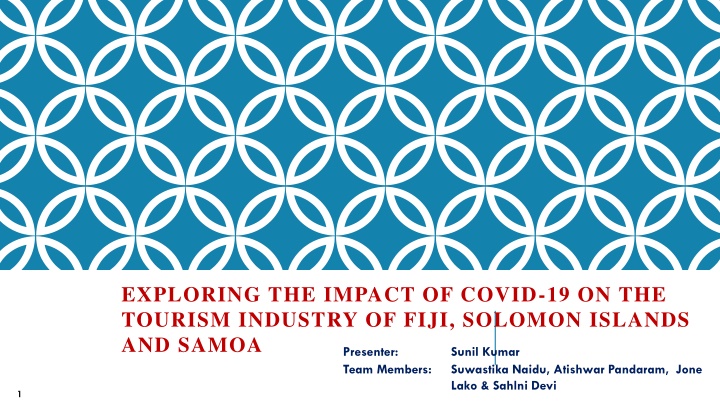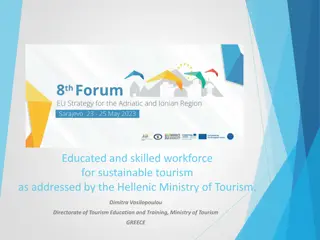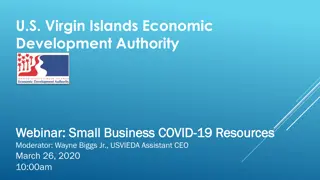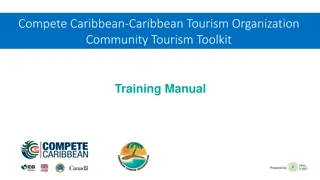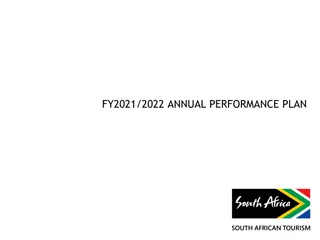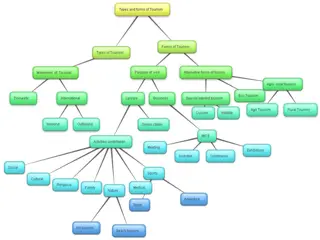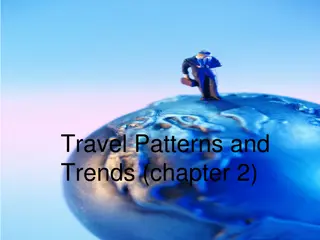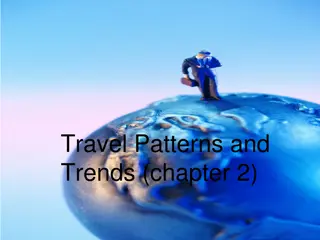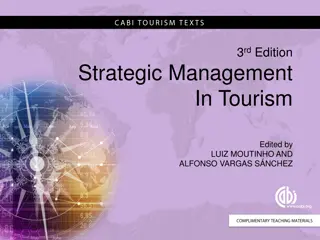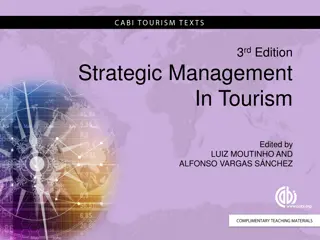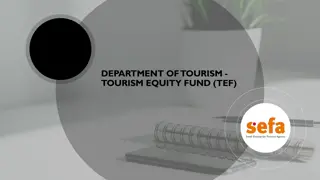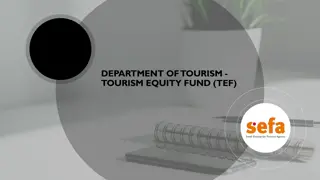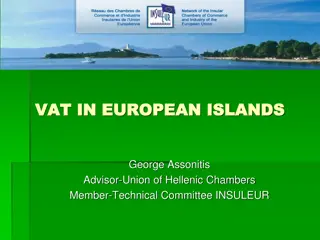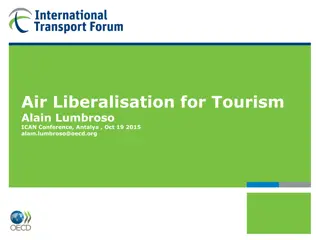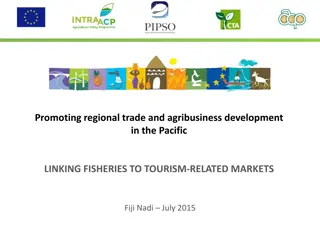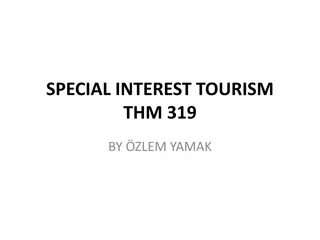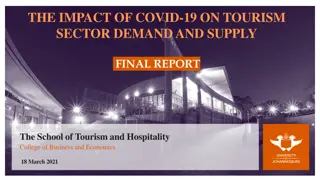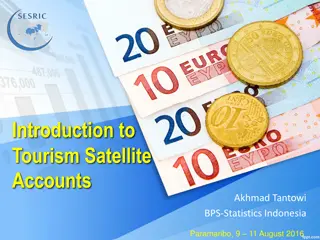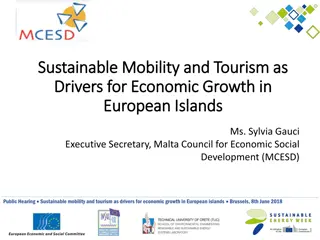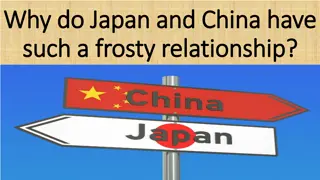Impact of COVID-19 on Tourism in Pacific Islands
Delve into the economic repercussions of COVID-19 on the tourism industry in Fiji, Solomon Islands, and Samoa. Explore the direct impacts, government responses, and projected trends outlined in the thorough analysis presented by Sunil Kumar, Suwastika Naidu, Atishwar Pandaram, Jone Lako, and Sahlni Devi.
Download Presentation

Please find below an Image/Link to download the presentation.
The content on the website is provided AS IS for your information and personal use only. It may not be sold, licensed, or shared on other websites without obtaining consent from the author.If you encounter any issues during the download, it is possible that the publisher has removed the file from their server.
You are allowed to download the files provided on this website for personal or commercial use, subject to the condition that they are used lawfully. All files are the property of their respective owners.
The content on the website is provided AS IS for your information and personal use only. It may not be sold, licensed, or shared on other websites without obtaining consent from the author.
E N D
Presentation Transcript
EXPLORING THE IMPACT OF COVID-19 ON THE TOURISM INDUSTRY OF FIJI, SOLOMON ISLANDS AND SAMOA Presenter: Team Members: Sunil Kumar Suwastika Naidu, Atishwar Pandaram, Jone Lako & Sahlni Devi 1
OUTLINE OF THE PRESENTATION 1.0 Introduction 2.0 Background of COVID-19 in the Pacific Island Countries (PICs) 3.0 COVID-19 Economic Trends in Fiji, Samoa and the Solomon Islands 4.0 Status of COVID-19 Cases in Fiji, Samoa and Solomon Islands 5.0 Direct Impact of COVID-19 on the Tourism Sector of Fiji, Samoa and the Solomon Islands 6.0 National Governments Fiscal Stimulus Package to Revitalize the Contracting Economy 7.0 Tourism Related Recovery Policies 8.0 Conclusion and Policy Options 2
1.0 INTRODUCTION Covid-19 hit PICs in around late March of 2020 when some cases were detected and visitor arrivals into Fiji dropped sharply. Significant Restrictions were placed on Movement: In Hospitals and key Government enclosures; Social distancing rules were put in place; Closure of international borders and quarantine measures were established; By April 2020 - PICs came under full grips of the restrictions. Countries relying heavily on Tourism were hit hard from the downturn; Tourism Related services were equally affected; PICs are now facing deep economic contraction this year with expected economic contract of more than -5.5% in the year 2020 (IMF, 2020). Global Economy expected to decline by around 4.4% (As per October IMF est.) 3
2.0 BACKGROUND OF COVID-19 IN THE PACIFIC ISLAND COUNTRIES (PICS) Figure 1: Real GDP Actual and Latest Projects Average Real GDP of the PICs is expected to significantly fall from 2.2% in the year 2019 to -5.5% in the year 2020. 3 2.2 2 1.4 Actual and Latest Projections Year over Year change, %) 1 0 2019 2020 2021 Year -1 -2 -3 -4 -5 -5.5 -6 Source: IMF (2020) 4
3.0 Projected Economic Trends for Fiji, Samoa and the Solomon Islands Table 1: Actual and Projections of Real GDP Pacific Island Countries (PICs) 2019 (%) 2020 (%) -19.5 (RBF) 2021 (%) Fiji (Highly Dependent on Tourism) -1.3 11.5 21% (IMF) -11.4 -8.3 -5 -5 -4.5 -3.8 -3.3 -2.5 -1.1 -0.5 0.7 Palau Vanuatu Samoa Solomon Islands Marshall Islands Micronesia Papua New Guinea Tonga Kiribati Tuvalu Nauru -1.8 3.3 3.5 1.2 5.3 1.2 4.9 0.7 2.3 6 1 -7.4 4.3 -1.5 4.5 -0.9 1.2 1.2 -3.5 3 3 1.3 Source: RBF (2020); IMF (2020) 5
3.0 Current Account Balance (% Of GDP) Table 2: Current Account Balance (% of GDP) Pacific Island Countries (PICs) Fiji Samoa Solomon Islands Year 2020 2019 2021 -12.9 2.3 -9.6 -15.3 -7.1 -11.3 -12.1 -7.0 -16.4 Source: IMF (2020) 6
3.0 Fiscal Account Balance (% of GDP) Table 3: Fiscal Account Balance (% of GDP) Pacific Island Countries (PICs) Fiji Samoa Solomon Islands Year 2020 2019 2021 -5.1 2.7 -1.7 -19.2 -7.3 -5.6 -9.0 -9.8 -4.9 Source: IMF (2020) 7
4.0 COVID-19 CASES IN THESE PICS The outlook as per now looks good once international travel opens up, the situation could worsen drastically. Therefore, vaccine availability for PICs would be a crucial issue early 2021. Table 4: COVID-19 Situation in Fiji, Samoa and the Solomon Islands Country Total Confirmed Cases Total Confirmed Deaths New Confirmed Cases Proportion of Fatal Cases % Confirmed cases from the past 7 days 0 1 Confirmed cases from the past 14 days 1 1 Fiji Samoa Solomon Islands Updated as of 24 November 2020, 10:00 GMT+8 35 1 2 0 1 0 5.88% 0% 17 0 1 0% 1 1 Source: WHO (2020) and other sources. 8
5.0 DIRECT IMPACT ON THE TOURISM SECTOR OF PICS Figure 2: Percentage Contribution of Tourism to Exports (2017) In the year 2017, the tourism sector of Samoa contributed 60.1% to the exports followed by 48.5% to the exports of Fiji and 13.0% to the exports of the Solomon Islands. Source: PTO online database, SPTO 2018 Annual Visitor Arrivals Report, World Bank, Research Association of New Zealand, (2020) 9
5.0 PERCENTAGE CONTRIBUTION BY THE TOURISM INDUSTRY TO THE GDP Figure 3: Percentage Contribution by the Tourism Industry to the GDP In the year 2018, the tourism industry of Fiji contributed 38.9% to the GDP, followed by 30.4% to the GDP of Samoa and 12.5% to the GDP of the Solomon Islands. Source: PTO online database, SPTO 2018 Annual Visitor Arrivals Report, World Bank, Research Association of New Zealand, 2020 10
TOURISM ORIENTED COUNTRIES Fiji and Vanuatu are the worst affected whereas Samoa was moderately affected and Solomon Islands least affected From solid growth in January and February, tourist departures from Australia to Fiji and Vanuatu the two main destinations for Australian tourists in the South Pacific fell by 29.2% and 41.2%, respectively, in March 2020. By April, Fiji only received only about 80 arrivals from Australia, while Vanuatu recorded none. Total travel lockdown came into effect post-April 2020, which continues to date with some exceptions of medical emergencies. 11
ADB Projections Shown Graphically Some Observations 1) Fiji s Growth projection of 11% for 2021 (by IMF) looks good but depends on the revival of the tourism sector. 2) Palau and Cook Islands are likely to contract significantly in 2021. 3) Solomon Islands (Non-tourism country) is poised to grow by around 2.5% (4.5% as per IMF) in 2021. 4) Similarly, PNG (A non-tourism country) is poised to grow by around 3% (1.2% as per IMF) in 2021. 12
5.0 DIRECT IMPACT OF COVID-19 ON THE TOURISM SECTOR OF FIJI, SAMOA AND THE SOLOMON ISLANDS Table 8: Visitor Arrivals by Destination Country (Based On 12-Month Percentage Change) Country Fiji Solomon Islands 13.8 Samoa Micronesia Palau Papua New Guinea RMI Tonga Tuvalu Vanuatu Kiribati Q4 2019 -0.4 Q1 2020 -18.7 -36.3 -36.2 -24.3 -30.7 -17.9 Q2 2020 -99.2 -100 -100 -100 -100 -98.1 Q3 2020 -99.0 -100 -100 -100 -100 -97.3 Sept 2020 -98.8 -100 -100 -100 -100 -96.9 -10.7 -0.6 22.6 -0.8 2.5 30.8 8.8 11.0 16.9 -20.9 -41.3 -22.3 -2.0 -35.3 -100 -100 -100 -100 -100 -100 -100 -100 -100 -100 -100 -100 -100 -100 -100 Source: IMF (2020) 13
5.0 FIJIS TOURISM CASE SOME DETAILS In late March 2020, the Fiji Hotels & Tourism Association announced 93% closure of operations decline in the tourist numbers. According to ADB, Fiji s tourism industry is likely to return to the pre-COVID levels by 2023. However, much depends on how the vaccine is made available in the region (including Australia and New Zealand). As per July 2020 IFC survey, 50% of tourism businesses are currently in hibernation and or fully shut down while 35% are operating at reduced hours. 14
SOLOMON ISLANDS CASE Similarly in Solomon Islands businesses are either hibernating or completely shut down. From January to March 2020, the tourism declined sector in Solomon Islands declined to 50% in revenues (Lilomo, 2020). Beyond April 2020, the major hotels in the Solomon Islands experienced low occupancy of around 10% to 18% (Lilomo, 2020). This is expected to continue until the global situation normalizes. 15
SAMOAS CASE Tourism Earnings and Remittances declined by more than 60% in March 2020 (Samoa Bureau of Statistics, CBS (Fruean, 2020). As everywhere else the situation worsened beyond 90% once the global restrictions cam into effect post-April 2020 (Fruean, 2020). The situation continue now and expected to remain until mid 2021. 16
6.0 FIJI - NATIONAL GOVERNMENTS FISCAL STIMULUS PACKAGE TO REVITALIZE THE CONTRACTING ECONOMY In March 2020 the Fijian government announced Covid-19 Budget to adjust allocations to the 2019-20 National Budget. Under this adjustment new allocations to the health sector were considered to address the pandemic related expenditures. Under the government announcements, the Fiji National Provident Fund was allowed to release its funds to cater for those who lost their jobs. Around FJ$1 billion was earmarked for this purpose, which included government borrowing. The ADB increased its funding by another FJ$100 million and the World Bank provided a facility of FJ$5.5 million. Australia and New Zealand also made substantial amount of funds to the Fijian Government. Initially a total of approximately FJD 7million was made available by Australian and New Zealand. Additional FJ$23million was provided by Australia and New Zealand. 17
6.0 Fiji 2020-21 National Budget (Fiscal Stimulus package to revitalize the contracting economy) To ease the cost pressure on businesses, the mandatory FNPF employer and employee contributions were reduced to 5% for the period starting from the start of April December 2020. From 1 February 2020, the workers who had lost their jobs or were working for reduced hours were allowed to withdraw FJ$1000 from their FNPF accounts. Employees who were adversely affected by the COVID-19 restrictions were able to withdraw an initial amount of FJ$500 from their FNPF accounts. New funding measures were made available for businesses to create new employments. These were made available through credit assistance by the Reserve Bank of Fiji and funding by the Fiji Customs and Revenue Authority. A number of new measures were taken by the government to create employment through business assistance schemes. 18
6.0 Samoa - National Governments Fiscal Stimulus Package to Revitalize the Contracting Economy Table 9: Samoan Stimulus Package to Help Mitigate the Adverse Impacts of COVID-19 Funds $20.3million $12.5million $2.5million $27.5million $3.5million Areas Health Sector Response Private Sector Enhancement Coronavirus initiative To Households - Increasing the purchasing power of Samoans Ministry of Agriculture and Fisheries Source: Government of Samoa, (2020a) 19
6.0 Solomon Islands - National Governments Fiscal Stimulus Package to Revitalize the Contracting Economy Table 10: Solomon Islands Stimulus Package to Increase Aggregate Demand Funds $5 million $5 million $10 million $5 million $39 million $39 million $39 million Areas Monitoring State of Emergency Regulations Rental Relief Package Health grants Education support Infrastructure investment in wharfs Construction of major Upgrading of domestic ports Source: Solomon Islands Government. (2020) 20
7.0 TOURISM RELATED RECOVERY POLICIES Strong and Sensible national leadership is needed in PICs to address the current problems and to plan for the future; The workforce capabilities in PICs would need a new direction to enhance skills; The tourism sector would need special attention in Fiji and Samoa Solomon Islands would need new directions in Agriculture and Government service The whole PIC region would need to develop new tourism products with possible rejuvenated health facilities. 21
TOURISM RELATED RECOVERY POLICIES Regional leadership is needed to develop Pacific bubble to ensure that our borders open much earlier than expected to reduce the negative repercussions of the COVID-19 pandemic on the tourism industry in PICs. Scenario planning and provision of information are essential to support the successful implementation of tourism industry recovery plans. New forms of immediate support would be needed (for example, microfinancing schemes) to help businesses survive the current negative repercussions (Research Association of New Zealand, 2020). 22
7.0 TOURISM RELATED RECOVERY POLICIES The decline in employer and employee contributions to the National Provident Fund need to be reconsidered as soon as normalcy sets in. Governments need to apply new policies to align the banking system towards a greater flexibility in the loan rates and repayments (particularly relating to micro, small and medium enterprises). Domestic demand for imports should be substituted by increasing domestic demand for locally produced products. Importing policies need to be revitalised This involves investing in agriculture and agri-business ventures. Trade facilitation needs concerted efforts by the PIC governments. 23
8.0 CONCLUSION COVID-19 crisis has brought forward new challenges for the world but more so for PICs. Pics need to revitalize their domestic economies and rely less on inflows (remittances) and international tourism. However, these sectors need to be made more competitive and self-reliant Commodity manufacturing and trading may need a renewed attention among PICs despite their smallness. The PICs need to generate regional synergy to counter the negative repercussions of such crisis on PICs. 24
REFERENCES IMF. (2020). No Tourism Recovery in September. Retrieved fromhttps://www.imf.org/en/Countries/ResRep/PIS-Region IMF. (2020). Pacific Islands Monitor: Issue 13. Retrieved fromhttps://www.imf.org/en/Countries/ResRep/PIS-Region Lilomo, P. (2020). COVID-19 Casting a Dark Shadow on Solomon Islands Tourism. Retrieved from https://www.solomontimes.com/feature/covid19- casting-a-dark-shadow-on-solomon-islands-tourism/459 Research Association of New Zealand. (2020). Pacific Tourism: COVID-19 Impact and Recovery. Retrieved from https://corporate.southpacificislands.travel/wp- content/uploads/2020/05/Pacific-Tourism-Sector-Status-report-Final.pdf 25
